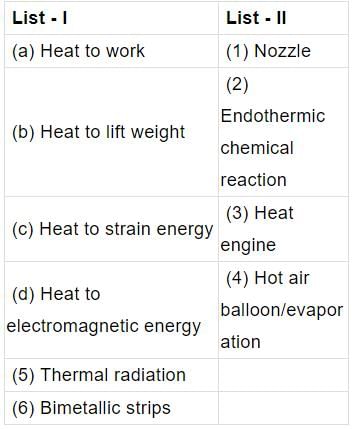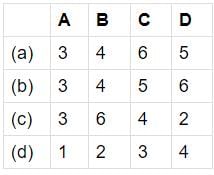Test: Basic Concepts of Thermodynamics - 1 - Mechanical Engineering MCQ
20 Questions MCQ Test - Test: Basic Concepts of Thermodynamics - 1
A balloon containing an ideal gas is initially kept in an evacuated and insulated room. The balloon ruptures and the gas fills up the entire room. Which one of the following statements is TRUE at the end of above process?
A system comprising a single phase is called a
The main cause of the irreversibility is
Which of the following are intensive properties?
1. Kinetic Energy
2. Specific Enthalpy
3. Pressure
4. Entropy
Select the correct answer using the code given below:
Consider the following:
1. Kinetic energy
2. Entropy
3. Thermal conductivity
4. Pressure
Which of these are intensive properties?
Consider the following properties:
1. Entropy
2. Viscosity
3. Temperature
4. Specific heat at constant volume
Which of the above properties of a system is/are extensive?
In highly rarefied gases, the concept of this loses validity
Isothermal compression of air in a Stirling engine is an example of
Assertion (A): In thermodynamic analysis, the concept of reversibility is that, a reversible process is the most efficient process.
Reason (R): The energy transfer as heat and work during the forward process as always identically equal to the energy transfer is heat and work during the reversal or the process.
Ice kept in a well insulated thermo flask is an example of which system?
A thermodynamic system is considered to be an isolated one if
Measurement of temperature is based on which law of thermodynamics?
Zeroth Law of thermodynamics states that
The constant volume gas thermometer works on the principle that
Assertion (a): If an alcohol and a mercury thermometer read exactly 0°C at the ice point and 100°C at the steam point and the distance between the two points is divided into 100 equal parts in both thermometers, the two thermometers will give exactly the same reading at 50°C.
Reason (R): Temperature scales are arbitrary.
Pressure reaches a value of absolute zero
Assertion (A): Thermodynamic work is path-dependent except for an adiabatic process.
Reason(R): It is always possible to take a system from a given initial state to any final state by performing adiabatic work only.





















